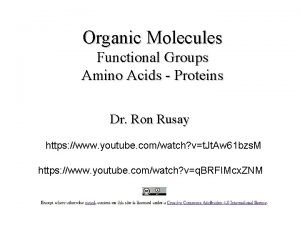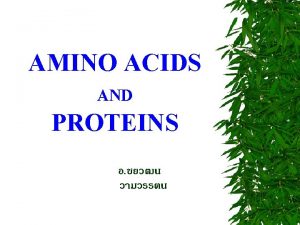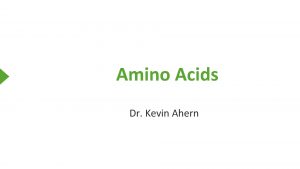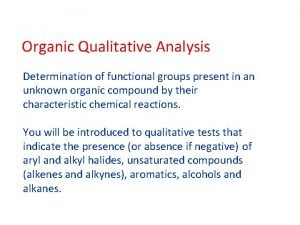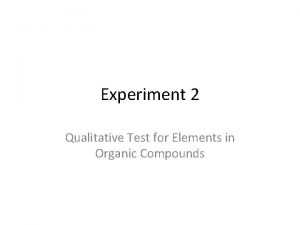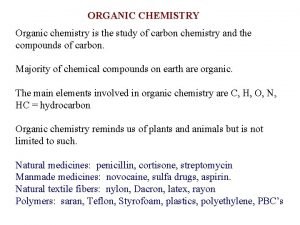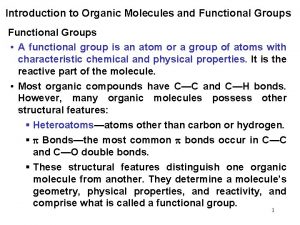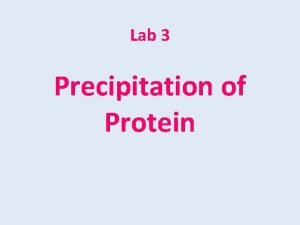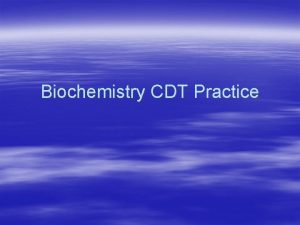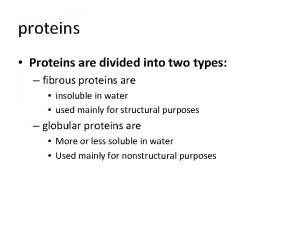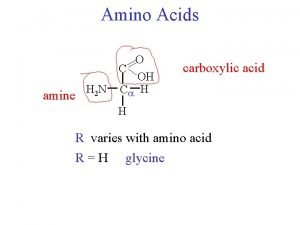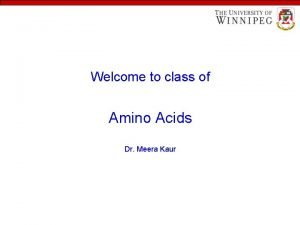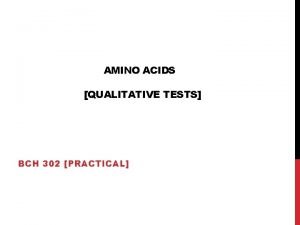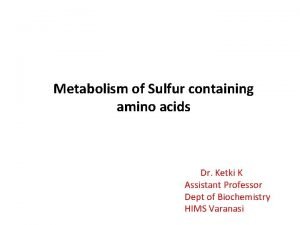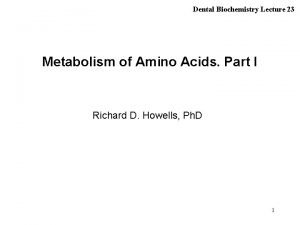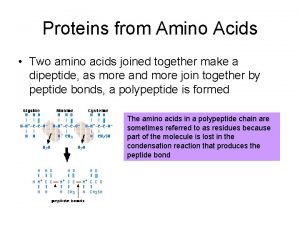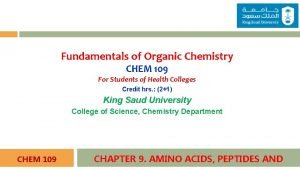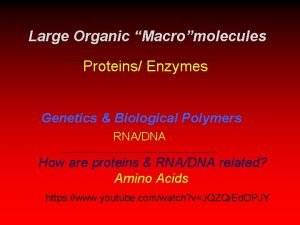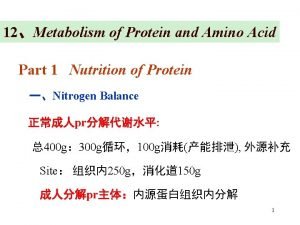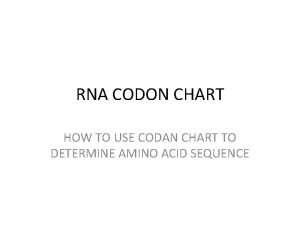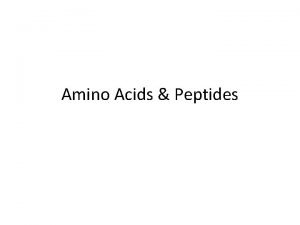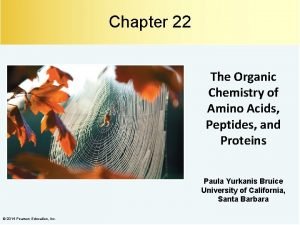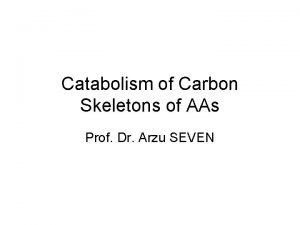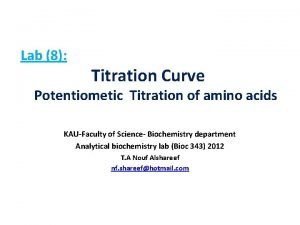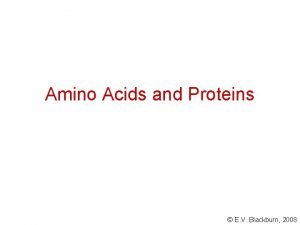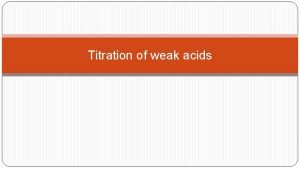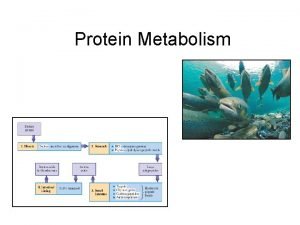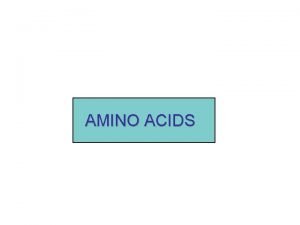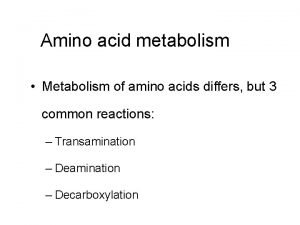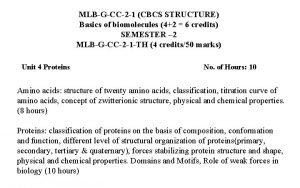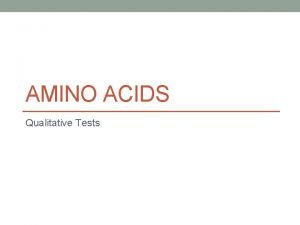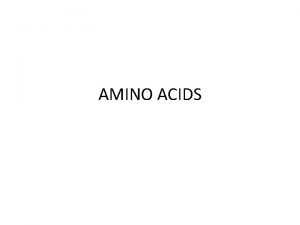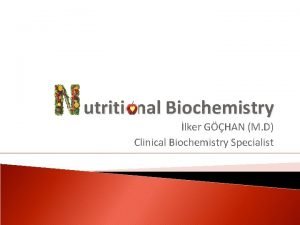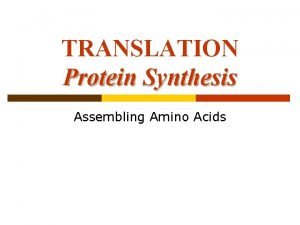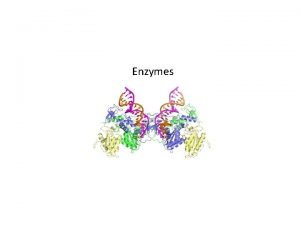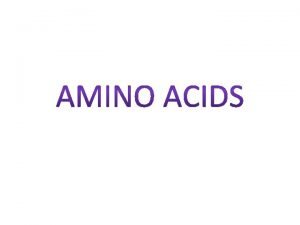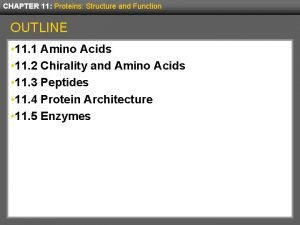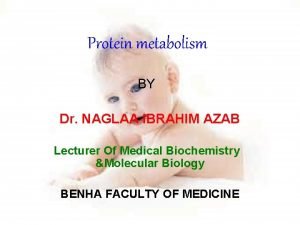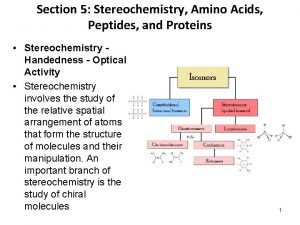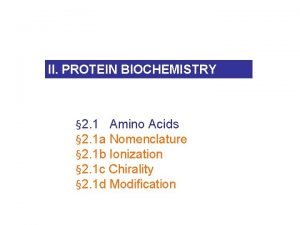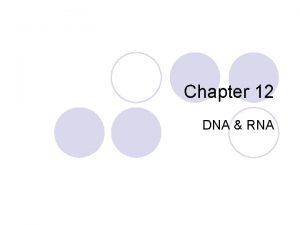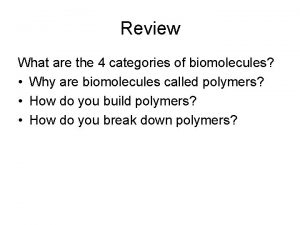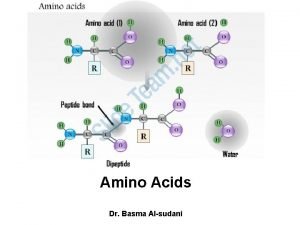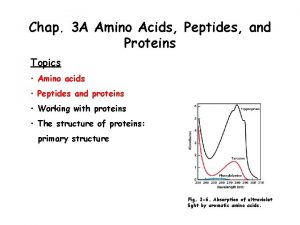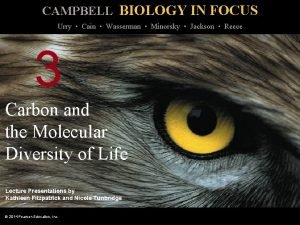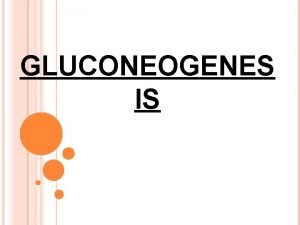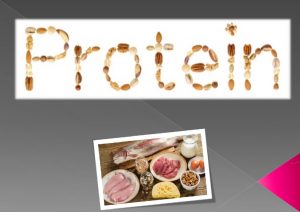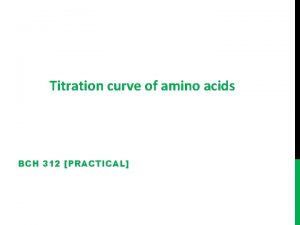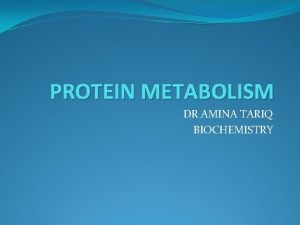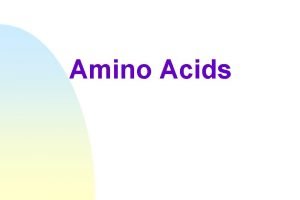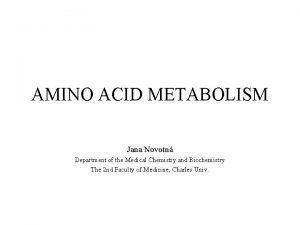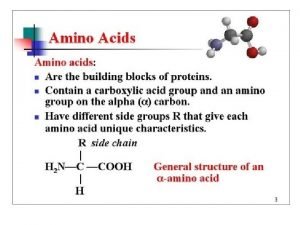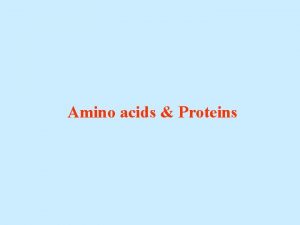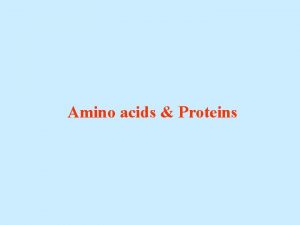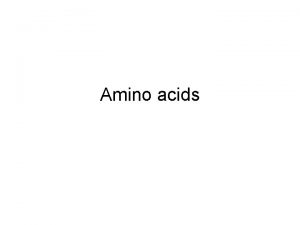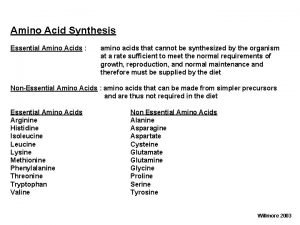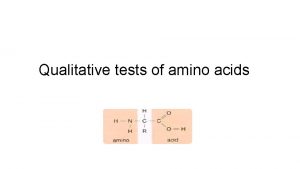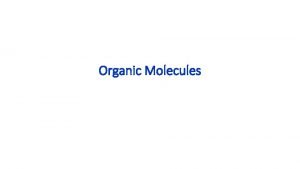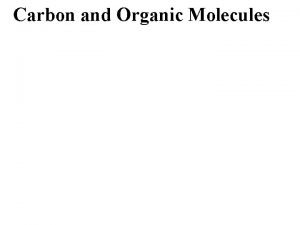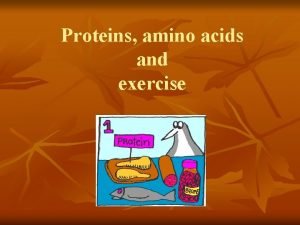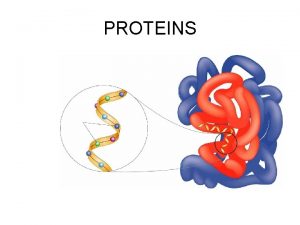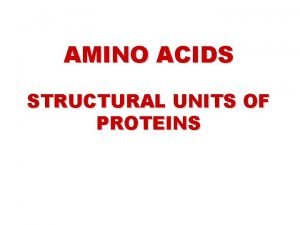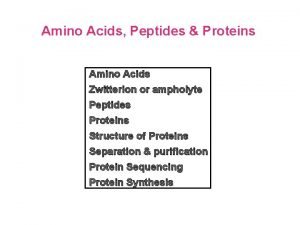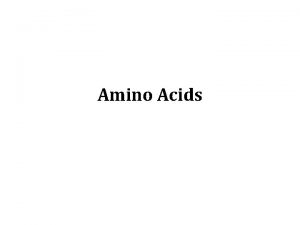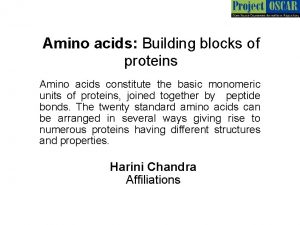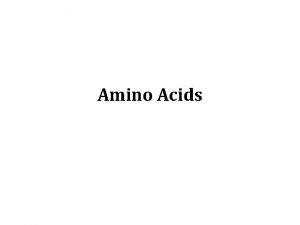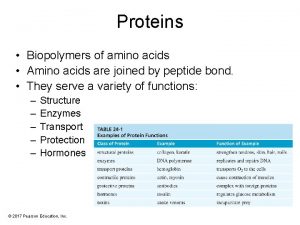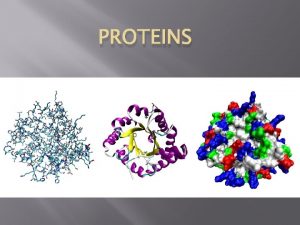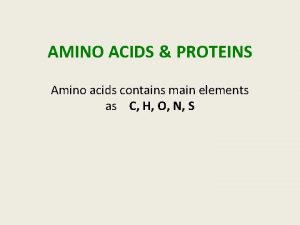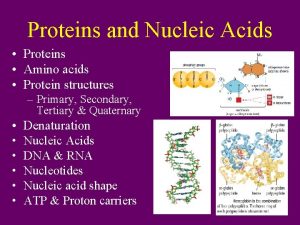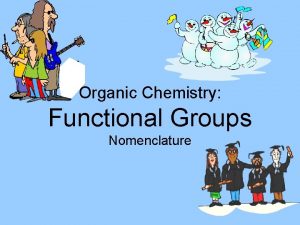Organic Molecules Functional Groups Amino Acids Proteins Dr























































- Slides: 55

Organic Molecules Functional Groups Amino Acids - Proteins Dr. Ron Rusay https: //www. youtube. com/watch? v=t. Jt. Aw 61 bzs. M https: //www. youtube. com/watch? v=q. BRFIMcx. ZNM

Small Organic Molecules Water, Ammonia, Methane molecular building blocks

Elemental building blocks for all organic molecules

Representing Organic Molecules http: //chemconnections. org/general/movies/Representations. MOV

Small Organic Molecules Common Functional Groups Name General Formula Alcohols R Ethers R R Amines R N 2 Carboxylic Acids

Small Organic Molecules Common Functional Groups Name Aldehydes Ketones Carboxylic Acids Esters Amides General Formula

Organic Formulas: Kekulé / Condensed / Bond-Line Structures / Drawings Molecular formula: C 7 H 16 O Empirical Formula: Bond-Line Structure: C 7 H 16 O

QUESTION A compound that smells like fresh raspberries, the following structure, C? H? O? , matches its calculated molar mass which is 164 g/mol. A) TRUE B) FALSE

ANSWER Based on your answers for the compound, which smells like fresh raspberries, in the previous two questions, the following structure matches its molecular formula. A) TRUE B) FALSE 164 g/mol = C 10 H 12 O 2

QUESTION Select the function(s) in the molecule Alcohol R Ether R R Amine R N 2 Aldehyde Ketone Carboxylic Acid Ester Amide

Answer Select the function(s) in the molecule X Alcohol R Ether R R Amine R N 2 Aldehyde X Ketone Carboxylic Acid Ester Amide

Large Organic Macromolecules Genetics & Biological Polymers RNA/DNA Proteins/ Enzymes How are proteins & RNA/DNA related? Amino Acids https: //www. youtube. com/watch? v=JQZQi. Ed. OPJY

Amino Acids Legos of Chemical Biology Amino acids contain carbon, hydrogen, oxygen, and nitrogen, which resemble the following shapes & structural components • 20 different amino acids are encoded by the genetic code, which is archived in DNA. • Hundreds of amino acids link together with amide (peptide) bonds to form proteins, which are the machinery for the chemistry of life. • There are less than 20, 000 total proteins produced from humans’ entire genome, each coded by a specific gene in DNA’s ~3 billion genetic bases. http: //chem. libretexts. org/Libre. Texts/Diablo_Valley_College/DVC_Chem_106%3 A_Rusay/Amino_A cids

Amino Acids Legos of Chemical Biology Amino acid structural components can be divided into four parts that are illustrated below. Only the side chain varies among the alpha (α-) amino acids. http: //chem. libretexts. org/Libre. Texts/Diablo_Valley_College/DVC_Chem_106%3 A_Rusay/Amino_A cids

Amino Acids Legos of Chemical Biology All amino acids contain C, H, O, and N; two, C & M. also have sulfur. http: //chem. libretexts. org/Libre. Texts/Diablo_Valley_College/DVC_Chem_106%3 A_Rusay/Amino_A cids

Proteins: Macromolecular Biopolymers Acetylcholinesterase (ACE) ACE, an enzyme, which catalyzes a key reaction in a repetitive biochemical cycle that is crucial to neurological and physiological functions in humans…. and insects among others. 4, 496 atoms; 4, 404 bonds 574 amino acid residues

10 m Length of some nerve and muscle cells 0. 1 m Chicken egg Unaided eye Human height You Light microscope 1 m Bones? Organs? 206 bones 78 organs 1 cm Frog egg Most plant and Animal cells 10 µ m Nucleus Most bacteria Mitochondrion 1 µ m Powers of Ten Smallest bacteria 100 nm Viruses 10 nm Organic Molecules millions Ribosomes Proteins 1 nm Lipids Small molecules 0. 1 nm Atoms Cells # of cells? ~5 x 1013 cells Electron microscope 100 µm Electron microscope 1 mm moles of cells? Proteins / DNA (Genome) ~22, 000 3 x 109 bases Measurements 1 centimeter (cm) = 10 2 meter (m) = 0. 4 inch 1 millimeter (mm) = 10 – 3 m 1 micrometer (µm) = 10 – 3 mm = 10– 6 m 1 nanometer (nm) = 10– 3 mm = 10– 9 m

10 m Length of some nerve and muscle cells 0. 1 m Chicken egg Unaided eye Human height Neanderthal Light microscope 1 m Bones? Organs? 1 cm Frog egg Most plant and Animal cells 10 µ m Nucleus Most bacteria Mitochondrion 1 µ m Powers of Ten Smallest bacteria 100 nm Viruses 10 nm Organic Molecules millions Ribosomes Proteins 1 nm Lipids Small molecules 0. 1 nm Atoms Cells # of cells? Electron microscope 100 µm Electron microscope 1 mm 206 bones Same as humans… organs? Proteins / DNA (Genome) 99. 7% is the same as humans Measurements 1 centimeter (cm) = 10 2 meter (m) = 0. 4 inch 1 millimeter (mm) = 10 – 3 m 1 micrometer (µm) = 10 – 3 mm = 10– 6 m 1 nanometer (nm) = 10– 3 mm = 10– 9 m

Genetic Controls Chromosomes (DNA/RNA) https: //ghr. nlm. nih. gov/primer/basics/howmanychromosomes Male or female?

Amino Acids & Proteins http: //chemconnections. org/general/movies/Proteins-amino-acids. mov Each amide group is called a peptide bond

Proteins (bio-polymers): Polypeptides, Amides and Proteins • Proteins are polyamides, each amide group is called a peptide bond. • Peptides are formed by condensation of the -COOH group of one amino acid and the –NH 2 group of another amino acid.

The 20 Key Amino Acids (22 with Archaea) • Amino acids are compounds that contain a basic —NH 2 amine group and an acidic —CO 2 H carboxylic acid group. • More than 700 amino acids occur naturally, but 20 (22? )of them are especially important. • These 22 amino acids are the building blocks of proteins. All are -amino acids. • They differ in respect to the group attached to the carbon.

Amino Acids: The basic amino group and acidic carboxylic acid group are actually present as —NH 3+ and —CO 2– respectively. H + H 3 N C O – R • The amino acids in proteins differ in respect to R (“the side chain”). • The physical & chemical properties of the amino acid vary as the structure of R varies.

The 20 Amino Acids in Animals/Humans

(Amide bond)

Proteins (Polypeptides) Polypeptides • Polypeptides are formed with a large number of amino acids (usually result in proteins with molecular weights between 6000 and 50 million amu). Protein Structure • Primary structure is the sequence of the amino acids in the protein. • A change in one amino acid can alter the biochemical behavior of the protein. Eg. Sickle Cell Anemia

Proteins are Polymers of Amino Acids • Peptides have various numbers of amino acids. • Peptides are always written with the -NH 2 terminus on the left, -CO 2 H on the right. • Each amino acid unit is called a residue. • 2 residues = dipeptide, • 3 residues = tripeptide, • 12 -20 residues = oligopeptide, • Many residues = polypeptide.

QUESTION Proteins are made when amino acids form peptide bonds to link together. Which of the following contains the correct number and type of atoms that are necessary to define a peptide bond? A. B. C. D. One carbon, two oxygen, one nitrogen Two carbons, one oxygen, one nitrogen, one hydrogen One carbon, two oxygen, one nitrogen, two hydrogen One carbon, one oxygen, one nitrogen, one hydrogen

ANSWER D The carbon will contain a double bond to oxygen, a single bond to nitrogen that will also have a single bond to a hydrogen atom. Although not directly part of the peptide linkage, the carbon will have a single bond to some other atom as will the nitrogen atom.

Four Levels of Protein Structure • 1 o : (Primary) The linear sequence of amino acids and disulfide bonds. eg. ARDV: Ala. Arg. Asp. Val. • 2 o : (Secondary) Local structures which include, folds, turns, -helices and -sheets held in place by hydrogen bonds. eg. hair curls, silk, denaturing egg albumin • 3 o : (Tertiary) 3 -D arrangement of all atoms in a single polypeptide chain. eg. collagen • 4 o : (Quaternary) Arrangement of polypeptide chains into a functional protein, eg. hemoglobin.

Different Protein Types • Enzymes: Glutamine synthetase - 12 subunits of 468 residues each; total mol. wt. = 600, 000 daltons • Regulatory proteins: Insulin - -alpha chain of 21 residues, - beta chain of 30 residues; total mol. wt. of 5, 733 amu • Structural proteins: Collagen Connectin proteins, - MW of 2. 1 million g/mol; length = 1000 nm; can stretch to 3000 nm. • Transport proteins: Hemoglobin • Contractile proteins: Actin, Myosin • Specialized proteins: Antifreeze in fish (A gene was first defined as: one piece of DNA that codes for one protein. The definition is being expanded beyond proteins to include certain types of RNA. )

Proteins: Size, Shape & Self Assembly http: //www. stark. kent. edu/~cearley/PChem/protein. htm

Protein Structure • 1 o : The linear sequence of amino acids and disulfide bonds eg. ARDV: Ala. Arg. Asp. Val. • 2 o : Local structures which include, folds, turns, -helices and -sheets held in place by hydrogen bonds. • 3 o : 3 -D arrangement of all atoms in a single polypeptide chain. • 4 o : Arrangement of polypeptide chains into a functional protein, eg. hemoglobin.


Boiling Points & Hydrogen Bonding

Hydrogen Bonding • Hydrogen bonds, a unique dipole-dipole attraction (10 -40 k. J/mol).

http: //chemconnections. org/general/movies/Hydrogen. Bonding. MOV

Intermolecular Forces Hydrogen Bonding http: //chemconnections. org/general/movies /ice-structure. MOV

QUESTION Which pure substances will not form hydrogen bonds? I) CH 3 CH 2 OH III) H 3 C−NH−CH 3 II) CH 3 OCH 3 IV) CH 3 F A) I and II B) I and III C) II and III D) II and IV

ANSWER Which pure substances will not form hydrogen bonds? I) CH 3 CH 2 OH III) H 3 C−NH−CH 3 II) CH 3 OCH 3 IV) CH 3 F A) I and II B) I and III C) II and III D) II and IV

Visualizing Intermolecular Hydrogen Bonds J Zhang et al. Science 2013; 342: 611 -614 Fig. 1 STM and AFM measurements Published by AAAS

DNA: Size, Shape & Self Assembly http: //www. umass. edu/microbio/chime/beta/pe_alpha/atlas. htm Views & Algorithms 10. 85 Å

Hair: α-Helix Annenberg World of Chemistry #23 Proteins : http: //www. learner. org/resources/series 61. html http: //chemconnections. org/general/movies/protein-hair-2. mov

Hair: α-Helix

Silk: β-Sheets http: //chemconnections. org/general/movies/proteins-silk-2. mov

Cooking the perfect egg: denaturing albumin perfectly softboiled http: //chemconnections. org/general/chem 106/Tech%20 Prep/Protein%20 Activity%2 0 I-2016. html

Protein Structure • 1 o : The linear sequence of amino acids and disulfide bonds eg. ARDV: Ala. Arg. Asp. Val. • 2 o : Local structures which include, folds, turns, -helices and -sheets held in place by hydrogen bonds. • 3 o : 3 -D arrangement of all atoms in a single polypeptide chain. • 4 o : Arrangement of polypeptide chains into a functional protein, eg. hemoglobin.

• Tertiary structure is determined by the interactions among and between R groups and the polypeptide backbone. • While these three interactions are relatively weak, disulfide bridges, strong covalent bonds between the sulfhydryl groups (SH) of cysteine monomers, stabilize the structure.

Protein Shape: Forces, Bonds, Self Assembly, Folding 10 -40 k. J/mol 150 -1000 k. J/mol 700 -4, 000 k. J/mol Ion-dipole (Dissolving) 40 -600 k. J/mol 0. 05 -40 k. J/mol

Protein Structure • 1 o : The linear sequence of amino acids and disulfide bonds eg. ARDV: Ala. Arg. Asp. Val. • 2 o : Local structures which include, folds, turns, -helices and -sheets held in place by hydrogen bonds. • 3 o : 3 -D arrangement of all atoms in a single polypeptide chain. • 4 o : Arrangement of polypeptide chains into a functional protein, eg. hemoglobin.

The quaternary structure of hemoglobin, Hb (A tetramer) Hb: two alpha units of 141 residues, 2 beta units of 146


Hemoglobin and Oxygen Transport An allosteric effect & sickle cell anemia allosteric effector BPG: 2, 3 -Bisphoglycerate Oxygen BPG

Normal hemoglobin vs sickle cell hemoglobin Valine replaces Glutamate http: //chemconnections. org/Presentations/Columbia/slide 8 -3. html Firefox to listen

Summary
 Amino acids are joined together in proteins by
Amino acids are joined together in proteins by Organic molecules vs inorganic molecules
Organic molecules vs inorganic molecules 20 amino acid structure
20 amino acid structure Neutral amino acids
Neutral amino acids Alpha carbon
Alpha carbon Qualitative analysis of organic functional groups
Qualitative analysis of organic functional groups Sodalime test
Sodalime test Ib organic chemistry functional groups
Ib organic chemistry functional groups Chemistry organic
Chemistry organic Functional group
Functional group Precipitation of proteins by strong mineral acids
Precipitation of proteins by strong mineral acids Organic compounds such as proteins and starches are too
Organic compounds such as proteins and starches are too Proteins are divided into two groups
Proteins are divided into two groups Acid base chemistry of amino acids
Acid base chemistry of amino acids Amino acids classification
Amino acids classification Phenol containing amino acids
Phenol containing amino acids Meister cycle
Meister cycle Plp mechanism transamination
Plp mechanism transamination Two amino acids joined
Two amino acids joined Cn- hybridization
Cn- hybridization 20 amino acids structures
20 amino acids structures Non essential amino acids mnemonics
Non essential amino acids mnemonics Codan table
Codan table Biomedical importance of amino acids
Biomedical importance of amino acids ε-amino
ε-amino Non essential amino acids mnemonics
Non essential amino acids mnemonics Thioglycolic acid cosmetology
Thioglycolic acid cosmetology Titration plot
Titration plot Acid base properties of amino acids
Acid base properties of amino acids Titration curve of lysine
Titration curve of lysine Glutamate oxidative deamination
Glutamate oxidative deamination Arginine amino acid essential
Arginine amino acid essential Transamination
Transamination Properties of amino acids
Properties of amino acids Millon's test positive result
Millon's test positive result Net charges of amino acids
Net charges of amino acids Nitrogen removal from amino acids
Nitrogen removal from amino acids Genetic code wheel
Genetic code wheel What is made of amino acids
What is made of amino acids Classification of amino acids
Classification of amino acids Salt bridge amino acids
Salt bridge amino acids Transdeamination definition
Transdeamination definition What is protein
What is protein Kr
Kr Chapter grabber
Chapter grabber Nitrogen base
Nitrogen base Are amino acids negatively charged
Are amino acids negatively charged Positive charged amino acids
Positive charged amino acids Dehydration synthesis of amino acids
Dehydration synthesis of amino acids Protein amino acids
Protein amino acids Regulation of gluconeogenesis
Regulation of gluconeogenesis What is made of amino acids
What is made of amino acids Titration curve of amino acids
Titration curve of amino acids Transdeamination of amino acids
Transdeamination of amino acids Amino acids classification
Amino acids classification Jana novotn
Jana novotn


